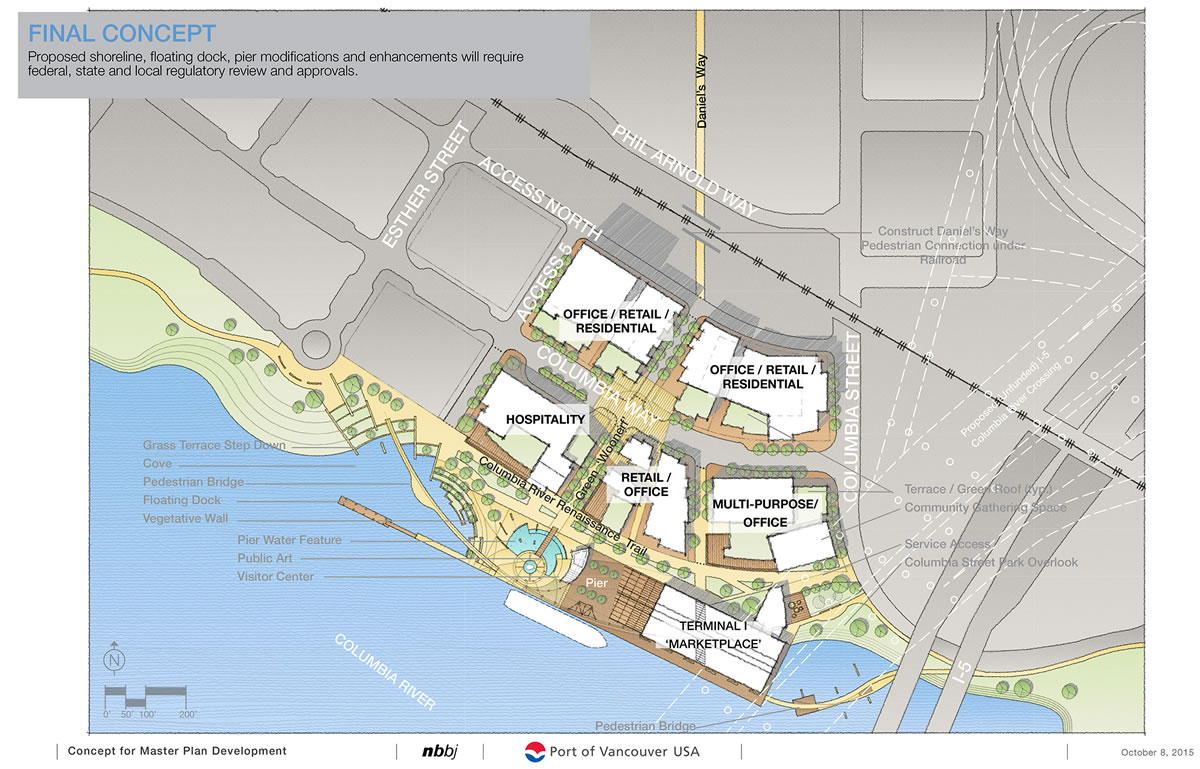If the Port of Vancouver and a private developer continue to lock horns over the future development of Vancouver’s waterfront, one thing is certain: Neither party will get the final say.
The job of referee goes to the city of Vancouver.
That’s the case as port commissioners are slated Tuesday to approve a broad plan for redeveloping 10 acres of the port’s Terminal 1 waterfront property. At the same time, commissioners are expected to increase spending on a Seattle-based consultant to give further shape to the plan.
Whatever final form that plan takes, the port, like any other land developer eyeing a project in Vancouver, must submit it to the city for review and final approval. And the port’s work today on its waterfront plan comes after tensions surfaced last month between the port and Barry Cain, president of Tualatin, Ore.-based Gramor Development. Cain already has an agreement with the city to spearhead a $1.3 billion redevelopment of 32 acres of former industrial waterfront land. The 32-acre site borders the port’s Terminal 1 property, west of the Interstate 5 entrance to Vancouver.
In early September, port leaders called into question the progress of Cain’s project and suggested they were taking the lead in redevelopment with their Terminal 1 effort. In response, Cain said the port, by pursuing its waterfront plan now and by including elements such as housing, was competing with and duplicating his project — to the detriment of the downtown area.
Cain, who recently publicly announced several new building deals for his project, also opposes another port effort: to become home to the nation’s largest rail-to-ship oil transfer terminal.
It’s anybody’s guess as to which turn the relationship between Cain and the port will take next. Ultimately, though, the city is poised to have the last word on whether the port’s waterfront proposal fits into the broader picture.
The port’s plan for Terminal 1 would undergo review by city staff for compliance with state environmental rules, receive inspection by the city’s hearings examiner and then go to the Vancouver City Council for any final changes and adoption, according to Chad Eiken, the city’s community and development director. The port could seek approval from the city to build on one or two lots at the site sooner while leaving development of the rest of the property in a more conceptual form.
But if the city council found the port’s plan to be inconsistent either with Cain’s project, the downtown area or the overall vision for the city’s waterfront development, Eiken said, then it “could certainly make that an issue” by withholding approval or seeking changes to the port’s plan. By way of context, the city council also opposes the oil terminal.
‘Still on track’
To be sure, the city council’s involvement in the port’s Terminal 1 plan isn’t imminent.
For now, the port commission will take its next steps during a public meeting to be held at 9:30 a.m. today at the port’s office, 3103 N.W. Lower River Road. One of those steps is to approve a final master plan concept for the Terminal 1 property, which currently includes the Red Lion Hotel Vancouver at the Quay. The Quay’s last day of business is Oct. 31.
The port’s plan calls for a mix of uses, including office, retail and residential, a hotel and a renovated Terminal 1 marketplace. It also calls for several other improvements, including a pedestrian bridge, floating dock, public art and a Renaissance Trail connector.
But there’s more work to be done on the master plan before the port submits it to the city. To that end, commissioners also are expected to increase spending on the services of NBBJ, the Seattle-based architecture firm that’s helping the port create the master plan.
The port originally awarded a contract of $300,000 to NBBJ. That was increased to $309,339 in April under port CEO Todd Coleman’s authority. Under the proposal before commissioners, the port would increase NBBJ’s contract by $61,995 to a total of $371,334.
The additional work by NBBJ is expected to include refinement of construction phasing and parking plans. Meanwhile, the port also anticipates issuing a request for qualifications in hopes of finding a consultant to help it navigate the city of Vancouver’s master plan application process, according to Magan Reed, a spokeswoman for the port.
That would be in addition to the request for proposals the port recently said it would issue to find a company interested in developing a hotel at the Terminal 1 site. The port and Red Lion ended exclusive negotiations about building a new hotel there, although the port has said it expects Red Lion will submit a proposal under the port’s upcoming solicitation process.
Port commissioners had been expected to vote on a preferred master plan for the Terminal 1 property on Sept. 22. But that didn’t happen, as the port decided to allow more time for review. Reed said the port still wants to break ground on a building at the Terminal 1 property by late 2016. “Many things can affect the timeline, but that’s our target date,” she said. “We believe we’re still on track.”




